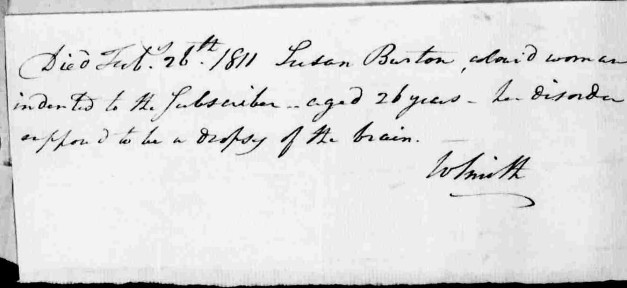 Twenty-eight-year-old Susan Burton died this date, February 28th, in 1811 of “Dropsy of the brain” and was buried at Bethel Burying Ground. Chronic Hydrocephalus – “Dropsy of the brain” is due to the meningitis virus and is marked by atrophy of the brain, mental weakness and convulsions.
Twenty-eight-year-old Susan Burton died this date, February 28th, in 1811 of “Dropsy of the brain” and was buried at Bethel Burying Ground. Chronic Hydrocephalus – “Dropsy of the brain” is due to the meningitis virus and is marked by atrophy of the brain, mental weakness and convulsions.
Ms. Burton was an indentured servant under the ownership of William Smith. Indentured servants were slaves, just by another name. They were considered the property of their owners. We don’t know how Ms. Burton came to this circumstance. When families applied for aid at the local almshouses, they often were required to indenture their children. This happened to both black and white families. However, most black children were indentured to the age of twenty-eight, while most white boys were indentured until they were twenty-one, and most white girls until they were eighteen. It would be a horrible scenario to think that Ms. Burton died just as she was scheduled to be freed from enslavement.

The only difference between being enslaved or indentured was that there was a supposed date that the individual would be set free. Indentured servants did not have the freedom to move about without a written note or to marry without their master’s permission. The penalty for doing so was the addition of one year of service to their contract. They were allowed to be whipped for any infractions and they had no real legal recourse.
Black female indentured servants were forced to be cooks, domestics, and nannies to the children of their white masters. I was unable to definitively identify the”William Smith” for whom Ms. Burton was forced to serve. He was either an attorney or wealthy merchant. Both of these men had large families and lived near the Delaware River in the old section of the city.
Free Black men also were allowed to own indentured servants. Clearly, Black businessmen did this for profit but also to provide protection to an individual, such as for a child who was orphaned or whose family was no longer able to care for him or her. In Philadelphia, situations like those were not uncommon. But, no matter what the circumstances, indentured servants often would run away from their masters – Black or white. Below are two advertisements that the Rev. Richard Allen, the founder of the AME, Bethel Church, and the Bethel Burying Ground, placed in the local newspapers offering rewards for two young males who decided they no longer wanted the good Reverend’s hospitality.

Dunlap’s Daily Advertiser, 29 May 1792

North American Intelligence, 28 September 1791. The young man’s name is “Sam.”
Susan Burton was buried on a warm day which broke a cold spell in late February.
*************************************************************************************
For further reading on Black women and indentured servitude, I suggest “A Fragile Freedom” by Erica Armstrong Dunbar.
















